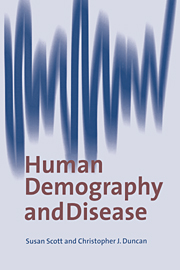Book contents
- Frontmatter
- Contents
- Preface
- Conversion table for imperial to metric units
- 1 Introduction
- 2 Tools for demography and epidemiology
- 3 Identification of population oscillations: a case study
- 4 Density-dependent control and feedback
- 5 Modelling the endogenous oscillations and predictions from timeseries analysis
- 6 Cycles in the grain price series
- 7 Interactions of exogenous cycles: a case study
- 8 Mortality crises and the effects of the price of wool
- 9 Modelling epidemics for the demographer: the dynamics of smallpox in London
- 10 Non-linear modelling of the 2-yearly epidemics of smallpox: the genesis of chaos?
- 11 Measles and whooping cough in London
- 12 Integration of the dynamics of infectious diseases with the demography of London
- 13 Smallpox in rural towns in England in the 17th and 18th centuries
- 14 Infectious diseases in England and Wales in the 19th century
- 15 Prospectives – towards a metapopulation study
- References
- Index
10 - Non-linear modelling of the 2-yearly epidemics of smallpox: the genesis of chaos?
Published online by Cambridge University Press: 25 January 2010
- Frontmatter
- Contents
- Preface
- Conversion table for imperial to metric units
- 1 Introduction
- 2 Tools for demography and epidemiology
- 3 Identification of population oscillations: a case study
- 4 Density-dependent control and feedback
- 5 Modelling the endogenous oscillations and predictions from timeseries analysis
- 6 Cycles in the grain price series
- 7 Interactions of exogenous cycles: a case study
- 8 Mortality crises and the effects of the price of wool
- 9 Modelling epidemics for the demographer: the dynamics of smallpox in London
- 10 Non-linear modelling of the 2-yearly epidemics of smallpox: the genesis of chaos?
- 11 Measles and whooping cough in London
- 12 Integration of the dynamics of infectious diseases with the demography of London
- 13 Smallpox in rural towns in England in the 17th and 18th centuries
- 14 Infectious diseases in England and Wales in the 19th century
- 15 Prospectives – towards a metapopulation study
- References
- Index
Summary
The changing dynamics of smallpox in London was traced in Chapter 9; it emerged there as an endemic, lethal disease by 1647 and the interepidemic interval gradually fell from 4 to 3 to 2 years, linked to a progressive rise in Nβ (the product of population size and susceptibility). Major 2-yearly epidemics were developed during 1750 to 1800, but thereafter the effects of vaccination became established and both the endemic level and the amplitude of the epidemics were sharply reduced, as shown in Fig. 9.1. Was smallpox characterised by 2-yearly epidemics elsewhere in England before vaccination modified the biology of the disease? In this chapter, the pattern of smallpox epidemics is first studied in large cities outside London, using the data that is available for the 18th century. Secondly, the linearised model of infectious diseases developed in Chapter 9 is compared with a full nonlinearised model which is described in section 10.5 and, finally, the existence of chaos in the dynamics of infectious diseases is discussed.
Deaths in smallpox epidemics in Scotland
There is little direct evidence for the status of smallpox in the 17th and 18th centuries in large cities other than London, although there have been a number of suggestions that the disease was endemic in such cities as Nottingham, Chester, Northampton, Norwich and Manchester after 1725 and before it was brought under control first by inoculation and then by vaccination (Mercer, 1985).
However, some quantitative data are available for Scotland. During the last two decades of the 18th century, smallpox killed over 36 000 people in Glasgow, which constituted nearly a fifth of all deaths in that period.
- Type
- Chapter
- Information
- Human Demography and Disease , pp. 189 - 221Publisher: Cambridge University PressPrint publication year: 1998



